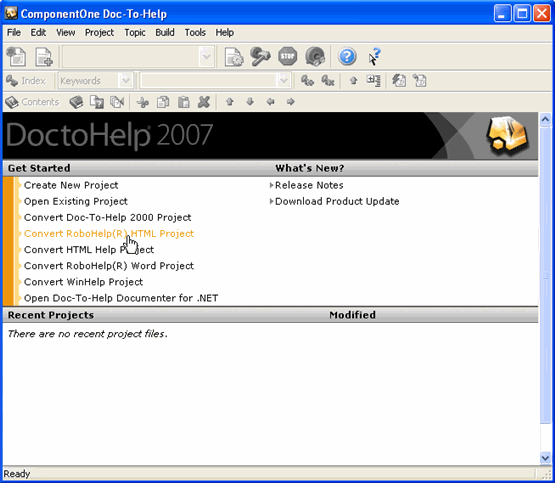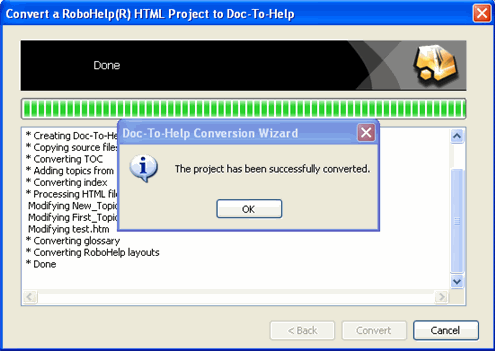This section describes the particulars of the RoboHelp HTML to Doc-To-Help conversion.
Files:
All files in the RoboHelp project folder and its subfolders are copied to the Doc-To-Help project folder except those that are used by RoboHelp for its internal purposes. This is done to ensure that external files that may be referenced in the project source files are present in the converted folder and do not cause broken links. If you see files that you know are not needed, you can delete them manually.
Topics:
Converted topic files form the Doc-To-Help document tree. The tree hierarchy is based on the table of contents (TOC) defined in the RoboHelp project (not on the topic hierarchy that may be different from TOC). For each TOC book that does not have a corresponding topic, an empty topic file is created, with name prefix “_D2H_”.
Topic templates, headers and footers:
Doc-To-Help does not have a concept of topic templates. However, no information is lost in conversion. Template headers and footers become a permanent part of topic content. So you will see headers and footers in converted topics exactly as they were in the source document, the only difference is that changes you make to headers and footers in the Doc-To-Help project apply only to the topic to which it belongs, not to other topics that were based on the same topic template in the RoboHelp project.
Style Sheets:
Style sheets that you use in the RoboHelp are preserved and continue to define the appearance of your topics. The Doc-To-Help target style sheet C1H_Source_short.css is added to each topic. It only defines Doc-To-Help Markup Language (D2HML) styles; it does not alter the appearance of your CSS styles.
TOC:
The RoboHelp TOC is converted to a Doc-To-Help TOC, which is automatically generated from topics (from the document tree hierarchy) if possible, customized if necessary.
Index keywords:
Index keywords are converted to Doc-To-Help index keywords. They appear on the Index tab in Doc-To-Help. Keywords are defined by D2HML hot spots, using the C1HIndexInvisible style, in topic files, so they can be modified in Doc-To-Help either on the Index tab of the Project Editor or in topic HTML text using D2HML.
See Also keywords:
These keywords are converted to Doc-To-Help groups. They appear on the Index tab in Doc-To-Help. Groups are defined by D2HML hot spots, using the C1HGroupInvisible style, so they can be modified in Doc-To-Help either on the Index tab of the Project Editor or in topic HTML text using D2HML.
Glossary:
The glossary is converted to a Doc-To-Help glossary, a multiple topic document, Glossary.htm.
Browse Sequence:
Browse sequence defined in RoboHelp in the Browse Sequence Editor is not converted, because the Doc-To-Help browse sequence is always determined by the topic hierarchy, that is, the document tree hierarchy. If you need to change the default browse sequence, rearrange topic files in the document tree in Doc-To-Help. Be aware that this changes your TOC when you build; you may need to customize your TOC before or after you rearrange the document tree.
Single source layouts:
RoboHelp single source layouts are converted to Doc-To-Help help targets. A property specified in a RoboHelp layout is converted to a Doc-To-Help target property only if Doc-To-Help supports that property. The following properties are converted:
|
Help Target |
RoboHelp Property |
Doc-To-Help Property |
|
HTMLHelp: |
Conditional Build Expression |
HelpTarget.AttributeExpression |
|
|
Default Topic |
Default Topic |
|
Default Window |
HelpTarget.DefaultWindow | |
|
Binary TOC |
HelpTarget.BinaryTOC
| |
|
WebHelp (converted to the Doc-To-Help NetHelp target): | ||
|
|
Conditional Build Expression |
HelpTarget.AttributeExpression |
|
|
Default Topic |
Default Topic
|
|
JavaHelp:
|
Conditional Build Expression |
HelpTarget.AttributeExpression |
|
Default Topic |
Default Topic | |
|
Enable TOC |
HelpTarget.ContentsTab | |
|
Enable Index |
HelpTarget.IndexTab | |
|
Enable Search |
HelpTarget.SearchTab | |
|
Enable Favorites |
HelpTarget.FavoritesTab | |
|
TOC Label |
HelpTarget.StringContents | |
|
Index Label |
HelpTarget.StringIndex | |
|
Search Label |
HelpTarget.StringSearch | |
|
Favorites Label |
HelpTarget.StringFavorites
| |
|
Printed Documentation (converted to the Doc-To-Help Manual target): | ||
|
|
Conditional Build Expression |
HelpTarget.AttributeExpression |
|
Name of the printed documentation |
HelpTarget.Title | |
|
Include expanding text |
HelpTarget.ShowExpandText | |
|
Include drop-down text |
HelpTarget.ShowDropdownText | |
|
Chapter layout |
TOC for the Manual target
| |
|
Project Settings|Language|Advanced|LNG File: | ||
|
|
[Common] |
|
|
|
Contents |
StringContents |
|
|
Index |
StringIndex |
|
|
Search |
StringSearch |
|
|
SyncToc |
StringSyncToc
|
|
|
[BrowseSequence] |
|
|
|
PreCaption |
StringPrevious |
|
|
NextCaption |
StringNext
|
|
|
[WebHelp] |
|
|
|
IndexInputPromt |
StringIndexCaption |
|
|
FtsInputPromt |
StringSearchCaption |
|
|
TopicNotFound |
StringFoundZero |
|
|
FtsBtnText |
StringSearchGo
|
|
|
[PrintedDoc] |
|
|
|
TableOfContents |
HTMLTarget(Manual).StringContents |
Printed documentation chapter layout:
In RoboHelp, you can customize the contents of your printed documentation, the order and hierarchy of topics, and, in essence, the TOC for the Printed Documentation target. Customized chapter layout is converted to the Manual target TOC in Doc-To-Help. You can see the Manual TOC on the Contents tab of the Doc-To-Help Project Editor. If it differs from the main TOC of the project; the converted TOC is customized separately from the main TOC, that is, the Manual target has its OwnTOC property set to True. If there are more than one Print Documentation layouts in the RoboHelp project that have customized chapter layout different from the main project TOC, additional Manual targets are created in the converted Doc-To-Help project, each with its own customized TOC.
Printed documentation section layout:
This layout is not converted to Doc-To-Help, because Doc-To-Help does not support custom section breaks in the Manual target. Doc-To-Help creates default sections, separate sections for the title, contents and index and for each top-level chapter.
Printed documentation style mapping:
In RoboHelp, you can map HTML styles to Word styles for printed documentation. This mapping is not converted to Doc-To-Help, because Doc-To-Help provides a different, more versatile, mechanism of determining the target appearance of styles. If you have a custom style mapping for printed documentation in your RoboHelp project, use the HelpTarget(Manual).StyleSheet property to achieve the same effect in the converted Doc-To-Help project. Copy the default style sheet (for the Manual target, it is C1H_Print_short.css) to your project directory and modify it; define the appearance for styles or tags whose appearance you want to change in the Manual target document. Note that you only need to do it for styles whose appearance needs to be different in the printed document than it is in the online targets. If you want a style or tag to look the same in Manual as it looks in HTML-based targets, that will be done automatically, without the need to modify the Manual target style sheet.
Conditional build tags:
Conditional build targets are converted to Doc-To-Help attributes. You can see the attributes in the Attributes node of the Doc-To-Help Project Editor tree view. In addition to the attributes created for conditional build tags, there is a HeadersAndFooters attribute created to control the inclusion of headers and footers in help targets. Headers and footers are included in online targets and excluded from the Manual target.
Conditional build expressions in layouts:
Conditional Build Expressions in RoboHelp layouts are converted to Doc-To-Help property HelpTarget.AttributeExpression.
Topic-level conditional build tags:
Conditional build tags specified in the properties of a RoboHelp topic are converted to a D2HML topic properties hot spot, using the C1HTopicProperties style, in the Doc-To-Help topic text.
Conditional build tags in topic text:
Conditional text in a RoboHelp topic is converted to D2HML conditional text hot spots, using the C1HConditional style, in the Doc-To-Help topic text.
Hyperlinks:
Hyperlinks are converted to D2HML hot spots, using the C1HJump style, in topic text.
Popups:
Pop-ups are converted to D2HML hot spots, using the C1HPopup style, in topic text.
Keyword Links:
Keyword links are converted to D2HML hot spots, using the C1HKeywordLink style, in topic text.
See Also Control:
These are converted to D2HML hot spots, using the C1HGroupLink style, in topic text.
Related Topics Control:
These are converted to D2HML hot spots, using the C1HGroupLink style, in topic text. For each Related topic control, a special group is created in the Doc-To-Help project, with the name prefix “RelatedTopics_”. These groups can be seen on the Index tab of the Doc-To-Help Project Editor, select Groups in the Index toolbar combo box to see the group.
Text-only Popups:
Text-only pop-ups are converted to D2HML inline pop-up hot spots using the C1HInlinePopup style.
Expanding Text:
Expanding text is converted to D2HML inline expand hot spots using the C1HInlineExpand style.
Drop-down Text:
Drop-down text is converted to D2HML inline drop-down hot spots using the C1HInlineDropdown style.
Glossary hotspots:
RoboHelp and Doc-To-Help use the glossary in different ways. The RoboHelp glossary is a tool for creating expanding text hotspots; the user creates glossary hotspots in topic text explicitly, there is no automatic detection of glossary terms in topic text. In Doc-To-Help, glossary terms are detected in topic text automatically. Since the RoboHelp glossary is converted to a Doc-To-Help glossary document, glossary hotspots in topic text are detected and marked as pop-up links when Doc-To-Help builds a help target, although they are not converted to a hot spot in Doc-To-Help.
Note: Doc-To-Help displays glossary terms as pop-ups in help targets, although RoboHelp displays them as expanding text.
Dynamic HTML Effects:
Dynamic HTML effects such as Blur, Fly in, etc. are removed from HTML topic files, because they are based on proprietary RoboHelp scripts.
Note: RoboHelp scripts are removed to make HTML source clean and vendor-independent. After the conversion, you can add effects supported by your HTML editor.
Image maps:
Although image maps are not converted to Doc-To-Help-specific constructs, they are left intact in topic files and will work in online help targets as expected. Building a help target, Doc-To-Help honors links specified in AREA tags in image maps, so they point to the correct URL for the topics to which they link.
Note: The URL of a topic in the target is defined by the Doc-To-Help Topic.URL property which by default has the same value as the source topic file path.
Windows:
Windows specified in the RoboHelp project are converted to Doc-To-Help windows with the same names. Doc-To-Help window properties are set for HTML Help and WinHelp targets based on the values of corresponding properties in the RoboHelp project.
Map IDs:
Map IDs are converted to topic context IDs in the Doc-To-Help project.
To convert a RoboHelp project:
1. Generate a Microsoft HTML Help layout for your RoboHelp project. This creates the HTML Help project (.hhp) used by the Doc-To-Help RoboHelp converter.
2. Open Doc-To-Help 2007 and click Convert RoboHelp(R) HTML Project.

3. Browse to locate a RoboHelp project for the conversion in the Open dialog box.
4. Select the project file (.xpj or .mpj) and click Open.
5. Review the location and click Next.

6. Enter the name of the Doc-To-Help project to be created in the Name text box.
7. Browse for a location for the new project.

8. Click the Convert button to begin the conversion. A window appears showing the conversion process.
9. Once the conversion is complete, click OK.

10. Click the Close button to close the Convert dialog box. Your new Doc-To-Help project opens in the Doc-To-Help project editor. You can being customizing and building your help files.